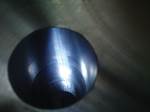Hole quality defined
In the aerospace industry, drilled hole quality is defined by ISO 286: System of Limits and Fits, a coordinated system of hole and shaft tolerances that is used in both engineering and production.
In manufacturing — and the prerequisite engineering — it is not possible to make components to an exact size every time. Thus, the amount the actual molded component’s size may deviate from the target dimensions must be known and listed along with its nominal measurements. A component’s maximum and minimum permissible size are known as its limits and their difference is termed the tolerance. These definitions also apply to the holes drilled to accommodate fasteners when joining multiple components to form an assembly.
ISO 286: System of Limits and Fits is a coordinated system of hole and shaft tolerances that is used in both engineering and production. It is defined and maintained by the International Organization for Standardization (ISO, Geneva, Switzerland), an independent, nongovernmental organization that comprises members from the national standards bodies of 161 countries. The ISO 286 standard states, “hole basis fits [as opposed to shaft basis fits] have four preferred hole tolerances (H11, H9, H8, and H7).” Hole basis fits are used when holes are made with standard machine tools (drills, reamers or end mills). The above hole tolerances are used to indicate the precision of drilled holes in aerostructures.
Fig. 1 shows a typical hole size and tolerance designation where size is most commonly given in milimeters (mm). The smaller the IT number, the more precise the hole diameter. Cutting-tool manufacturers often use H8, H7, etc. interchangeably with IT8, IT7, etc., to describe the precision of drilled holes.
According to Dr. Peter Mueller-Hummel, senior manager for the aerospace and composites business unit of Mapal (Aalen, Germany), “the standard for drilled hole tolerance in aerospace metals is H7, meaning that the diameter does not vary more than .010 mm [0.0004 inch or 0.4 mil].” He notes that the hole tolerance in The Boeing Co.’s (Chicago, Ill.) 787 Dreamliner program was initially relaxed to H8, or ±0.018 mm (0.0007 inch or 0.7 mil), but because the holes being drilled still could not consistently meet that, the tolerance was dropped again to H9 at ±0.04 mm (0.002 inch or 2.0 mil).
The other measure of hole drilling precision given is CPK, or Cpk, which is defined as process capability index, a statistical tool that measures the ability of a process to meet specifications. It compares the process data distribution — e.g., hole diameter — to the specification limits and predicts future performance. A CPK >1.3 is required for “reliable and safe” drilling operations in aerostructures, according to Mueller-Hummel, and 1.7 is necessary for OEM qualification (a higher number indicates better performance). Thus, the CPK of 2.4 that Mapal reports for its new tool in the dry drilling of a wingbox assembly’s stacked materials is impressive.
Related Content
-
Industrializing additive manufacturing in the defense/aerospace sector
GA-ASI demonstrates a path forward for the use of additive technologies for composite tooling, flight-qualified parts.
-
First Airbus A350 crash confirmed in Haneda
Shortly after touch-down, a JAL A350-900 aircraft recently collided with a De Havilland Canada Dash 8. Exact circumstances are still unknown.
-
Welding is not bonding
Discussion of the issues in our understanding of thermoplastic composite welded structures and certification of the latest materials and welding technologies for future airframes.






